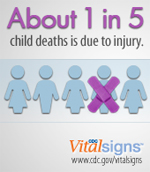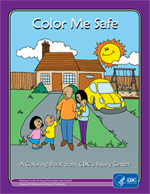A National Action Plan for Child Injury Prevention
Reducing Motor Vehicle-related Injuries in Teens
Download Print Version [312KB PDF]

Motor vehicle crashes kill more teens in the United States than any other cause of death. More than 3,200 teens ages 15-19 died in such crashes in 2009, and more than 340,000 others were injured.1 Most motor vehicle-related deaths and injuries are predictable and preventable.
A National Action Plan
The Centers for Disease Control and Prevention (CDC) is committed to preventing child injury by supporting solutions that will save lives. The National Action Plan for Child Injury Prevention (NAP) was developed by CDC and more than 60 stakeholders to spark action across the nation. The overall goals of the NAP are to raise awareness about the problem of child injury and the effects on our nation, offer solutions by uniting stakeholders around a common set of goals and strategies, and mobilize action to reduce child injury and death.
The NAP contains six domains that include goals and actions based on what we know, where we need to go, and how we can get there. See below for examples of what we can do to further reduce motor vehicle-related injuries among teens.
Data and Surveillance—includes the ongoing and systematic collection, analysis, and interpretation of child health data for planning, implementing, and evaluating injury prevention efforts.
- Enhance access, usability, and timeliness of Crash Outcome Data Evaluation Systems (CODES) in states that have them, to document contributing factors to crashes involving teen drivers and the resulting severity and cost of associated injuries.2
- Work with selected states to structure and link licensing, crash, and health care databases in order to better document nonfatal teen driver crashes and more fully evaluate the effectiveness of graduated driver licensing systems. Examples of the needed driver information include driver examination results; issue dates for learner driver permit, intermediate license, and unrestricted license; license suspension information; violation and crash history.
Research—includes research gaps and priorities in risk factor identification, interventions, and program evaluation, and dissemination strategies needed to reduce injuries.
- Design, implement, and evaluate strategies to motivate and assist parents to closely supervise their newly licensed teen driver that are based on accepted adult learning principles.
- Evaluate the role and effectiveness of state driver license examinations in ensuring a basic level of knowledge and safety among newly-licensed teen drivers.
Communication—includes effective strategies to promote injury prevention to target audiences through designing messages and information and delivering them through relevant channels.
- Collaborate with police and media to personalize teen driver news stories and promote effective teen driver safety and enforcement programs.
- Encourage local media to report information on seat belt use, alcohol involvement, teen passenger presence and license status of the driver when reporting on teen driver crashes.
Education and training—includes organized learning experiences for increasing knowledge, attitudes, and behavior change conducive to preventing injuries.
- Design, implement, and evaluate learning strategies to motivate and assist parents to closely supervise their newly licensed teen driver that are based on accepted adult learning principles.
- Encourage driver education programs to update their curriculum and number of practice driving hours to comply with current national guidelines established by the American Driver and Traffic Safety Education Association.3
Health systems and health care—includes the health infrastructure required to deliver quality care and clinical and community preventive services. Health care providers can:
- Counsel parents and teens to learn and follow state GDL laws.4
- Encourage families to complete a parent-teen driving agreement that places restrictions on the common high-risk driving situations for teen drivers.
Policy—includes laws, regulations, incentives, administrative actions, and voluntary practices that enable safer environments and decision making.
- Support evidence-based strategies to reduce teen driver crash-related injuries, such as strong GDL systems and primary enforcement seat belt laws.
- Support improvement and enforcement of laws designed to limit the purchase, possession, and consumption of alcohol by underage adolescents.
Moving Forward Together
Everyone—including parents, health care providers, educators, and community members—can take steps to prevent injury where they live, work, and play. We all have a part to play in the NAP and in protecting our children—America’s future.
References
-
CDC. Web-based Injury Statistics Query and Reporting System [online]. National Center for Injury Prevention and Control, Centers for Disease Control and Prevention (producer). [2010 August 2].
-
The Crash Outcome Data Evaluation System (CODES) and Applications to Improve Traffic Safety Decision-Making. Available at: http://www-nrd.nhtsa.dot.gov/Pubs/811181.pdf. Accessed March 27, 2012.
-
American Driver and Traffic Safety Education Association. Available at: http://www.adtsea.org/adtsea/. Accessed April 10, 2012.
-
Centers for Disease Control and Prevention, National Center for Injury Prevention and Control. Parents are the Key: Graduated Driver Licensing. Available at: http://www.cdc.gov/ParentsAreTheKey/licensing/. Accessed April 10, 2012.
Get email updates
To receive email updates about this page, enter your email address:
Contact Us:
- Centers for Disease Control and Prevention
National Center for Injury Prevention and Control (NCIPC)
4770 Buford Hwy, NE
MS F-63
Atlanta, GA 30341-3717 - 800-CDC-INFO
(800-232-4636)
TTY: (888) 232-6348
New Hours of Operation:
8am-8pm ET/
Monday-Friday
Closed Holidays - cdcinfo@cdc.gov





